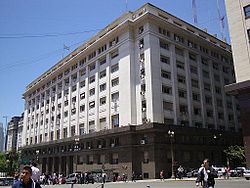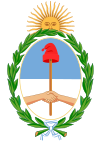Ministry of Productive Development
| Ministerio de Obras Públicas | |
 | |
 Palacio de Hacienda, headquarters of the Ministry | |
| Ministry overview | |
|---|---|
| Formed | 1949 (first creation) |
| Jurisdiction | Argentina |
| Headquarters | Palacio de Hacienda, Hipólito Yrigoyen 250, Buenos Aires |
| Annual budget | $ 129,937,317,367 (2021)[1] |
| Minister responsible | |
| Parent department | Government of Argentina |
| Website | argentina.gob.ar/produccion |
 |
|---|
|
The Ministry of Productive Development (Spanish: Ministerio de Desarrollo Productivo; MDP) of Argentina is a ministry of the national executive power that oversees and advises on the promotion of industrial policies and foreign trade in Argentina.
Since its establishment in 1949 it has been variously called Ministry of Industry, Industry and Commerce, Industry and Mining, Production, and Production and Labour. The ministry received its current name in 2019 in the incumbent cabinet of President Alberto Fernández; its current minister is Matías Kulfas, since 10 December 2019.
History[]
The Ministry of Productive Development was originally founded as the Ministry of Industry and Commerce in 1949, during the presidency of Juan Domingo Perón. Perón was especially interested in industrializing the Argentine economy, which at the time was heavily dependent on agriculture.[2] The first minister in the portfolio was José Constantino Barro, who served during Perón's first presidential term from 1949 until 1952.[3] In Perón's second presidential term, the ministry was renamed to simply "Ministry of Industry", a name that was retained by the military governments of Eduardo Lonardi and Pedro Eugenio Aramburu.[4]
Successive administrations revived the ministry under various names and with various additional responsibilities, including that of commerce and mining; otherwise the industry and production portfolios were organized as secretariats of the Treasury Ministry. Since 2019, the Ministry's official name is Ministry of Productive Development, with Matías Kulfas at its helm.[5]
Structure and dependencies[]
The Ministry of Productive Development counts with a number of centralized and decentralized dependencies. The centralized dependencies, as in other government ministers, are known as secretariats (secretarías) and undersecretariats (subsecretarías), as well as a number of other centralized agencies:[6][7]
- Secretariat of Domestic Trade (Secretaría de Comercio Interior)
- Undersecretariat of Domestic Trade Policies (Subsecretaría de Políticas para el Mercado Interno)
- National Competition Defense Commission (Comisión Nacional de Defensa de la Competencia)
- Undersecretariat of Consumer Defense Actions (Subsecretaría de Acciones para la Defensa de las y los Consumidores)
- Secretariat for Small and Medium-sized Businesses and Entrepreneurs (Secretaría de la Pequeña y Mediana Empresa y los Emprendedores)
- Undersecretariat of Pyme Financing and Competition (Subsecretaría de Financiamiento y Competitividad Pyme)
- Undersecretariat of Pyme Productivity and Regional Development (Subsecretaría de la Productividad y Desarrollo Regional Pyme)
- Undersecretariat of Entrepreneurs (Subsecretaría de Emprendedores)
- Secretariat of Industry, Economy and Foreign Trade Administration (Secretaría de Industria, Economía del Conocimiento y Gestión Comercial Externa)
- Executive Unit for the Argentine Foreign Trade Single Registry National Regime (Unidad Ejecutora del Régimen Nacional de Ventanilla Única de Comercio Exterior Argentino)
- National Foreign Trade Commission (Comisión Nacional de Comercio Exterior)
- Undersecretariat of Industry (Subsecretaría de Industria)
- Undersecretariat of Commercial Policy and Administration (Subsecretaría de Política y Gestión Comercial)
- Undersecretariat of Knowledge Economy (Subsecretaría de Economía del Conocimiento)
- Secretariat of Mining (Secretaría de Minería)
- Undersecretariat of Mining Development (Subsecretaría de Desarrollo Minero)
- Undersecretariat of Mining Policy (Subsecretaría de Política Minera)
- Secretariat of Energy (Secretaría de Energía)
- Undersecretariat of Electric Energy (Subsecretaría de Energía Eléctrica)
- Undersecretariat of Hydrocarbon Fuels (Subsecretaría de Hidrocarburos)
- Undersecretariat of Energy Planning (Subsecretaría de Planeamiento Energético)
Several decentralized agencies also report to the Ministry of Productive Development, such as the National Institute of Industrial Technology (INTI), the National Institute of Industrial Property (INPI), the Buenos Aires Central Market, and the Banco de Inversión y Comercio Exterior.[8][9][10]
Headquarters[]
The Ministry of Productive Development is headquartered in the Palacio de Hacienda ("Palace of the Treasury"), located in the Monserrat barrio in Buenos Aires, which has historically housed the Ministry of Economy (formerly known as the Ministry of the Treasury) as well as other ministerial portfolios such as public works and transport.[11] The building was built in two stages from 1937 to 1950 and stands on Hipólito Yrigoyen street, across from the emblematic Plaza de Mayo square and the Casa Rosada, seat of the Presidency.[12]
List of ministers[]
| No | Minister | Party | Term | President | ||
|---|---|---|---|---|---|---|
| Ministry of Industry and Commerce (1949–1952) | ||||||
| 1 | José Constantino Barro | Peronist Party | 7 June 1949 – 4 June 1952 | Juan Domingo Perón | ||
| Ministry of Industry (1952–1956) | ||||||
| 2 | Rafael Amundarain | Peronist Party | 4 June 1952 – 27 July 1954 | Juan Domingo Perón | ||
| 3 | Orlando Leonardo Santos | Peronist Party | 27 July 1954 – 21 September 1955 | |||
| 4 | Horacio Morixe | Independent | 23 September 1955 – 13 November 1955 | Eduardo Lonardi | ||
| 5 | Álvaro Alsogaray | Independent | 13 November 1955 – 8 June 1956 | Pedro Eugenio Aramburu | ||
| Ministry of Industry and Commerce (1956–1958) | ||||||
| 6 | Rodolfo Martínez | Christian Democratic Party | 8 June 1956 – 11 March 1957 | Pedro Eugenio Aramburu | ||
| 7 | Julio César Cueto Rúa | Independent | 19 March 1957 – 1 May 1958 | |||
| Ministry of Industry and Mining (1981) | ||||||
| 8 | Eduardo Oxenford | Independent | 29 March 1981 – 21 August 1981 | Roberto Viola | ||
| 9 | Livio Kühl | Independent | 22 August 1981 – 12 December 1981 | |||
| Ministry of Production (2002–2003) | ||||||
| 10 | José Ignacio de Mendiguren | Independent | 3 January 2002 – 3 October 2002 | Eduardo Duhalde | ||
| 11 | Aníbal Fernández | Justicialist Party | 3 October 2002 – 25 May 2003 | |||
| Ministry of Industry (2008–2015) | ||||||
| 12 | Débora Giorgi | Independent | 26 November 2008 – 10 December 2015 | Cristina Fernández de Kirchner | ||
| Ministry of Production (2015–2018) | ||||||
| 13 | Francisco Cabrera | Republican Proposal | 10 December 2015 – 16 June 2018 | Mauricio Macri | ||
| 14 | Dante Sica | Independent | 21 June 2018 – 5 September 2018 | |||
| Ministry of Production and Labour (2018–2019) | ||||||
| 14 | Dante Sica | Independent | 5 September 2018 – 10 December 2019 | Mauricio Macri | ||
| Ministry of Productive Development (2019–present) | ||||||
| 15 | Matías Kulfas | Independent | 10 December 2019 – incumbent | Alberto Fernández | ||
References[]
- ^ "Presupuesto 2021". Ministerio de Economía (in Spanish). 2020. Retrieved 20 November 2020.
- ^ Rapoport, Mario (2000). Historia económica, política y social de la Argentina (in Spanish). Buenos Aires: Emece. p. 377. ISBN 9789500428927.
- ^ Quién es quién en la Argentina: biografías contemporáneas (in Spanish). Buenos Aires: Guillermo Kraft Limitada. 1955. p. 72.
- ^ Sáenz Quesada, María (2011). La libertadora: De Perón a Frondizi (1955-1958) Historia pública y secreta [The Libertadora: from Perón to Frondizi (1955-1958) The public and secret history] (in Spanish). Buenos Aires: Sudamericana. ISBN 9789500734172.
- ^ Cayón, David (6 December 2019). "Matías Kulfas, el ministro de Desarrollo Productivo que tendrá la difícil tarea de que la economía vuelva a crecer". Infobae (in Spanish). Retrieved 5 May 2020.
- ^ "Ministerio de Desarrollo Productivo". argentina.gob.ar (in Spanish). Retrieved 29 April 2020.
- ^ "Ministerio de Desarrollo Productivo". jefatura.gob.ar (in Spanish). Retrieved 4 May 2020.
- ^ Tarricone, Manuel; Bertolini, Julieta (9 February 2018). "Despidos en el INTI: quién es Javier Ibáñez, su presidente". chequeado.com (in Spanish). Retrieved 5 May 2020.
- ^ "Cómo funciona el Mercado Central de Buenos Aires". Informe Digital Metropolitano (in Spanish). March 2017. Retrieved 5 May 2020.
- ^ "BANCO DE INVERSION Y COMERCIO EXTERIOR (BICE)". d20-ltic.org. Retrieved 5 May 2020.
- ^ "El Palacio de Hacienda fue declarado Monumento Histórico". nueva-ciudad.com.ar (in Spanish). 28 December 2018. Retrieved 1 May 2020.
- ^ Mejía, Virginia (28 December 2018). "Monumento histórico: el Palacio de Hacienda, mucho más que una sede ministerial". La Nación (in Spanish). Retrieved 1 May 2020.
External links[]
- Government ministries of Argentina
- 1949 establishments in Argentina
- 2008 establishments in Argentina
- Industry ministries
- Mining ministries
- Energy ministries
- Ministries established in 1949
